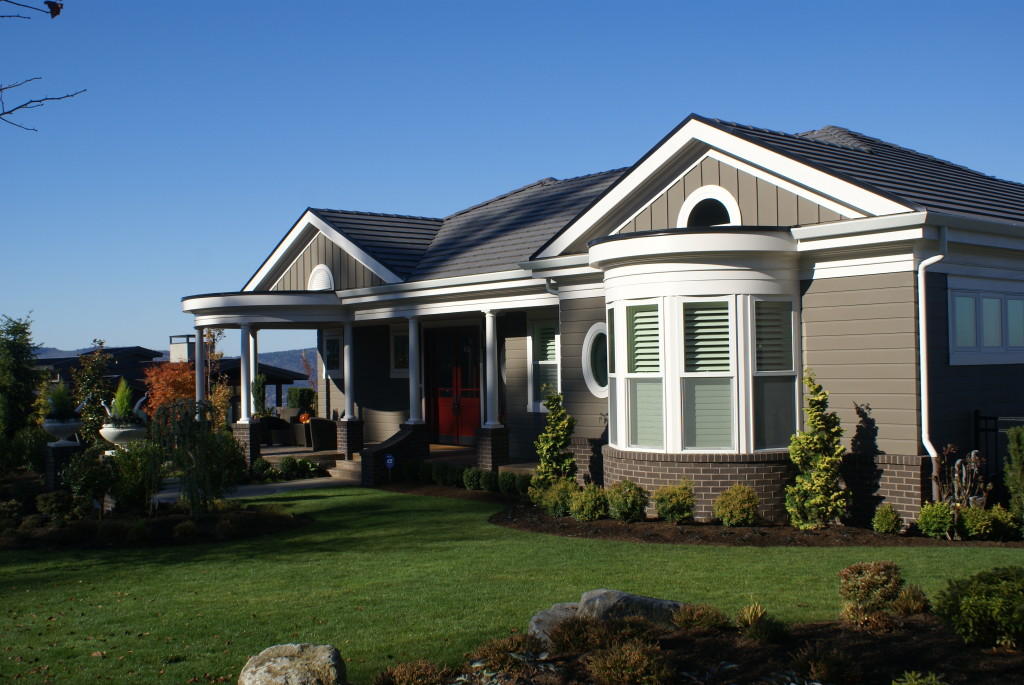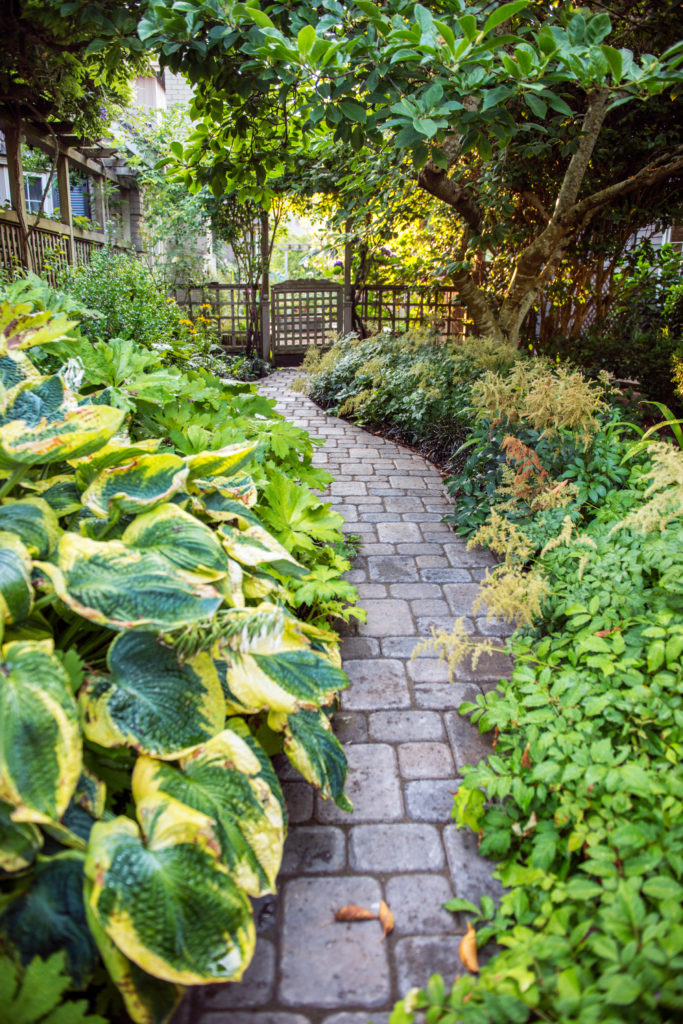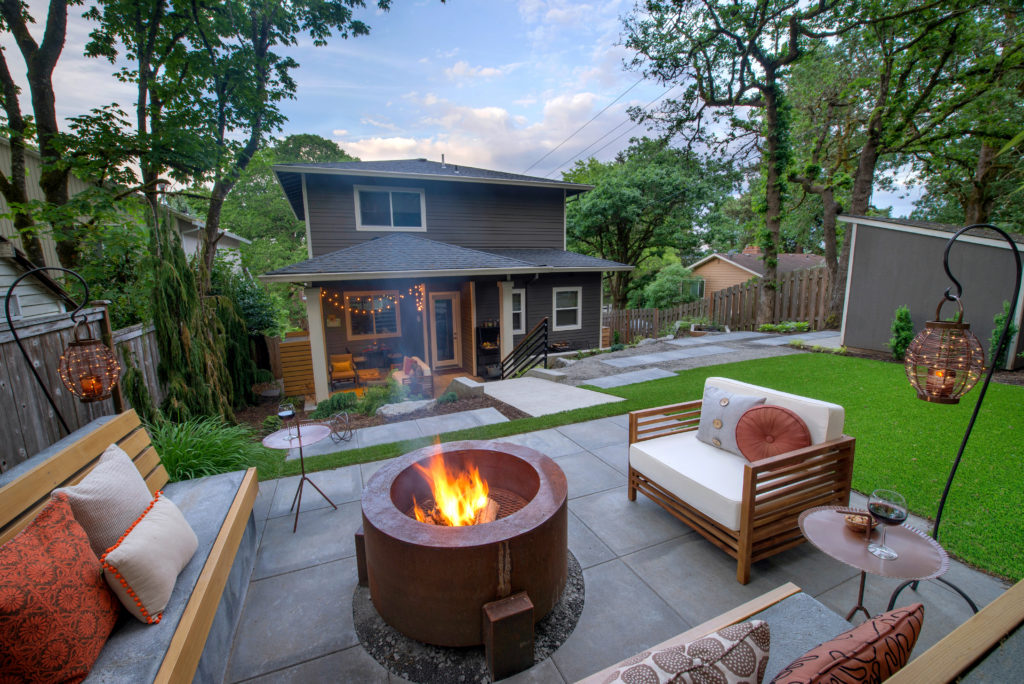It’s time to jettison boring backyards and generic outdoor living spaces in favor of statement spaces that speak to your design preferences and the character of your Pacific Northwest home. Here are some guidelines to keep in mind when choosing materials and furnishings for your patio, garden, firepit, walkways and other outdoor spaces.
Turn a Boring Backyard into a Statement Outdoor Space with Pacific Northwest Architectural Styles
Architectural Styles of the Pacific Northwest
While you might find just about every architectural style represented in homes throughout the Pacific NW, some of those you will most commonly find include Craftsman, Mid-Century Modern and its close variant Northwest Modern, Industrial and Bohemian.
Craftsman
Among the prominent features of Craftsman style homes are distinct and covered front porch spaces, gables, built-ins (cabinets, window seats, nooks) and extensive use of wood throughout the home. Craftsman homes often have great detail by combining different types of materials on the exterior including wood beams, wood siding (or concrete siding), brick, stone and shingles.
Replicating the Craftsman style of your home in your outdoor space means extending these ideas onto your patio. For instance, if you are covering your patio you might repeat the same type of triangular gables found on your home’s front exterior. You can use the same types of brick and stone façade to trim out columns; or concrete pavers and retaining wall blocks to create patios, walkways, planters and grow boxes, or raised borders. Add wood furniture in seating and dining. Build benches into your patio’s perimeter along with wood planters. And of course you can also stain your deck and other wood elements to mimic the colors found in your home’s indoor flooring.

Modern, Mid-Century Modern and Northwest Regional (a.k.a. Midwest Modern)
These styles are listed together here because while they have some differences, they also share many similar characteristics. While Craftsman homes are often two-stories, the homes that fall into this category might be one-story ramblers or split levels. They often have expansive windows (great for making the most of Pacific Northwest light – which can be sparse in the winter – as well as our breathtaking views), straight rooflines (or sometimes with very small gables), distinct entry areas, and vaulted ceilings. Furnishings are often low profile with straight horizontal lines, like the roofline of modern style homes. Lighting and fixtures are often brass or gold in color (vs. the stainless and brushes steel and bronze found in many Craftsman homes today). Skylights and use of glass in architectural materials is also common. Chief exterior materials include wood, siding, brick and concrete. As with Craftsman homes, roof materials are typically asphalt shingles.
To extend modern architectural style into your patio space, look for low profile furniture that has straight lines, especially across the top. Vault the ceiling of your covered outdoor space. Clad separating walls with horizontal wood planks in naturally-stained hues. Incorporate mid-century modern style light fixtures, chandeliers, overhead fans, serving and tableware and other accessories. For patio flooring and walkways consider square concrete tiles. The straight lines that characterize modern homes can be extended into nearly everything outside – from patio edging to retaining walls, planters and grow boxes, patio flooring, barbecue enclosures, furniture and fencing.

Industrial
Modern home styles are somewhat a mix of the traditional materials used in Craftsman design and urban industrial. Likewise, Industrial style draws from many of the same materials but puts them together in a much more urban, masculine way, thanks to the strong role that metal plays in Industrial design.
Industrial style is often very utilitarian and spare. It’s common to find exposed ceiling beams, joists, HVAC and piping in interior spaces. The wood is often unfinished, rustic, and sometimes even salvaged. Interior spaces are often very square with high ceilings. Metal features heavily in industrial design in lighting, appliances and even counter surface spaces. Concrete counters are also commonly found in industrial style spaces. Décor is often minimal; on the other hand, that gives you the ability to let statement art and lighting pieces dominate the feel of the space.
To extend Industrial style onto your patio and into your backyard’s walkways, garden scape, retaining walls, fencing, etc., let these same types of materials speak. Choose large square slabs over traditional concrete pavers for patio flooring. Incorporate salvaged materials as furniture. Use metal and concrete as well as natural wood as the major components of your patio, and even your furnishings. Keep accessories to a minimum and let a statement piece (such as a concrete patio table, large concrete firepit or outdoor fireplace) be the “star.”

Bohemian
While Bohemian is not technically an architectural building style, it is very much a style you will find throughout the Pacific Northwest, especially in urban areas like Seattle and Portland. It fits very well within our modern and industrial styled spaces.
Bohemian style is essentially eclectic. To pull off Bohemian design you must assemble items which are seemingly disparate in a way that makes them feel intentional, functional and somehow united. In Bohemian style you will usually find extensive use of found items, especially fabrics in wall hangings, blankets, pillows, and carpets. While you might find a few new items in these spaces, many will be repurposed or long-loved, inherited classic furnishings and accessories.
If Bohemian is your thing, you can use the same ideas to extend that style into your outdoor spaces, including your deck or patio, garden spaces and backyard. If anything, this style gives you the most freedom to assemble garden art, furniture and accessories that you love without regard to strict architectural style, materials or colors. Layer outdoor carpets to define your patio’s spaces. Add lots of pillows and throws that can easily be laundered. Mix cut flowers in vases alongside planters. Use backyard game items to accessorize. Add a hammock or hammock chair for relaxing in the sun. Mix metals, stone, wood, glass, concrete and other materials to your heart’s content!
When it comes to your outdoor spaces, marry distinct architectural style and your personal preferences to create a statement space that you will love to live in and look forward to entertaining in for years to come.


